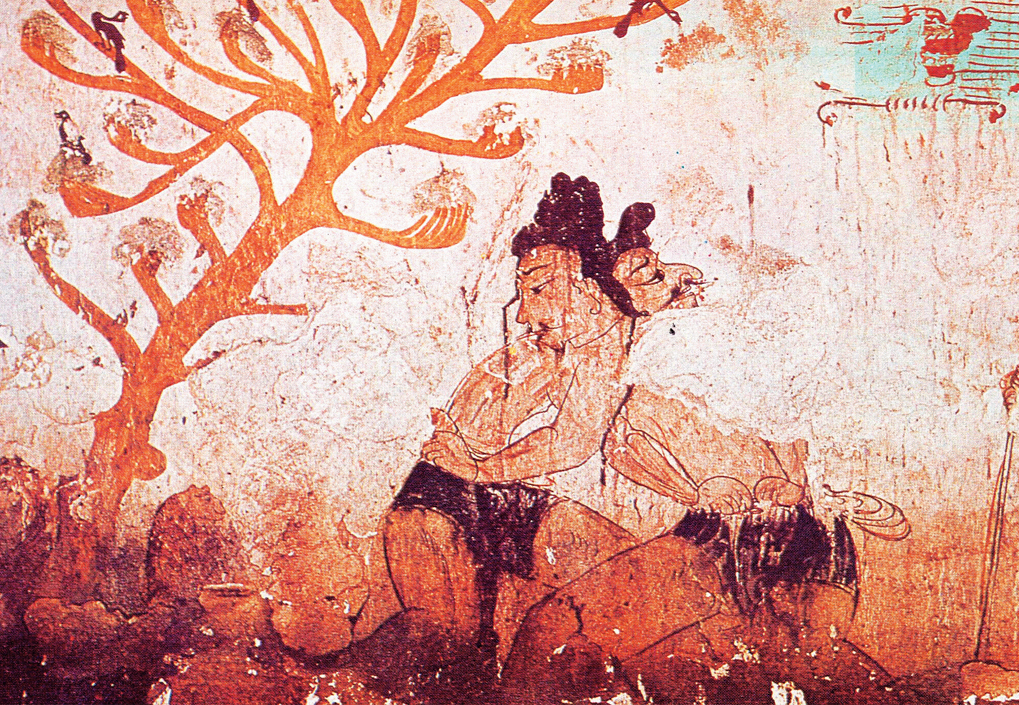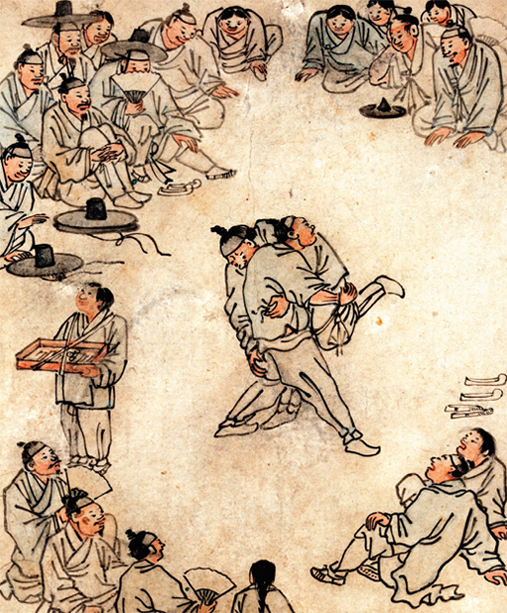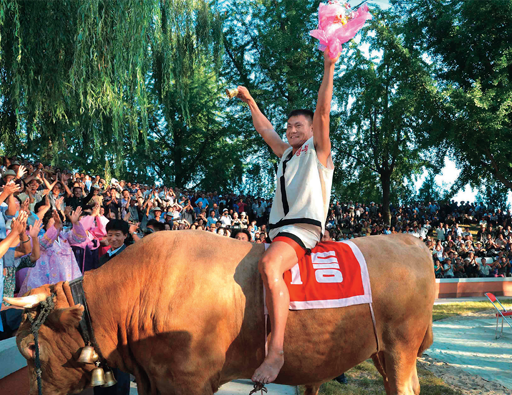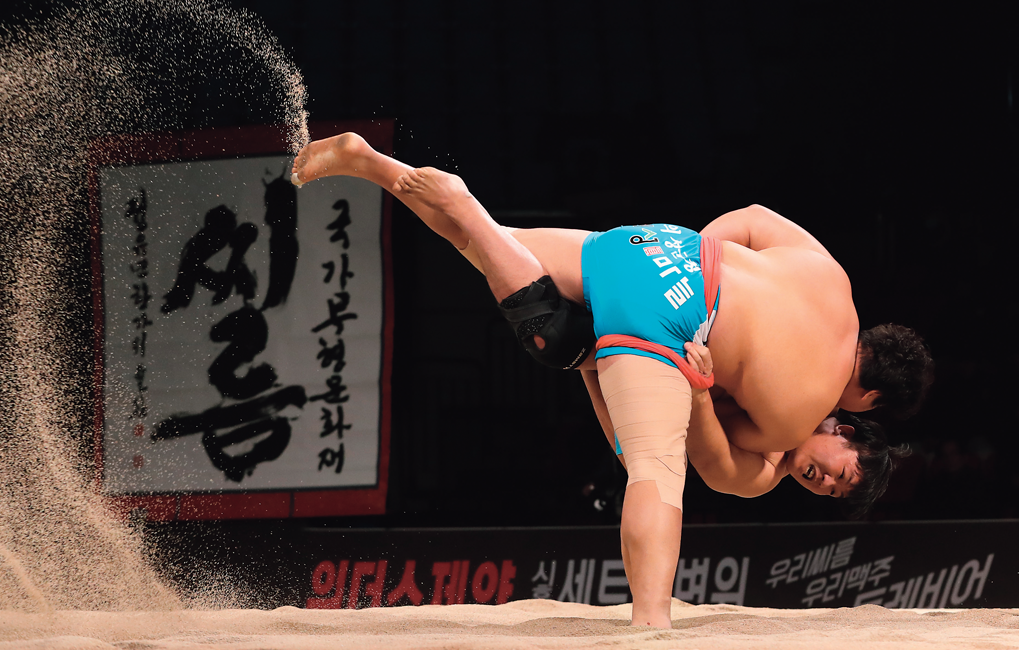In an unprecedented joint application, the two Koreas obtained the inscription of their common traditional sport ssireum on the UNESCO’s Representative List of the Intangible Cultural Heritage of Humanity. The inter-Korean effort has raised hopes for improved relations between the North and the South.

A scene from a mural in Gakjeochong (Tomb of Wrestlers), dated to the early 5th century during the Goguryeo Kingdom. This is the oldest known record of ssireum. The depicted positioning of the wrestlers is the same as that today.Courtesy of Park Hong-soon
Ssireum is an ancient Korean wrestling style and traditional sport. A cloth, called satba, is wrapped around the wrestlers’ waist and thigh and they hold on to each other’s cloth belt. In a match, getting any part of the opponent’s body above the knee to touch the ground first qualifies as a win. The ssireum matches, taking place in a small ring with mounded sand, require quick reactions, endurance and skillful coordination of the whole body, especially the hands, feet and back, as well as physical and mental toughness.
For Koreans, ssireum is more than a folk sport. The competitions have long been an integral part of every special day on the lunar calendar, heralding the beginning of a festival or holiday celebration. In the old days, everyone in a village participated as competitor or spectator.
In many ways, ssireum has also carried social and communal significance that transcended individuals’ talents and interests. This is why it remained a constant even in the first part of the 20th century when Korea lost its sovereignty and groaned under colonial oppression. Country-wide competitions were held as often as once a month, playing a role in maintaining the ethnic and cultural identity of Koreans. Eventually, toward the end of colonial rule, Japan banned the sport altogether.
Liberation and the ensuing territorial division did not diminish ssireum’s stature as a common legacy of the Korean people. In the south, even before the government of the Republic of Korea was founded, it was selected as a permanent part of the annual national sports festival, and large-scale games began at regional and national levels. Though not as widespread as it once was, many schools across the country still have ssireum teams and individual enthusiasts form teams that represent regions and corporations. Similarly, in North Korea, ssireum continues to have an important place as a major national sport and pastime. A nationwide competition is held every autumn during the Chuseok holiday period, and communities have matches on Dano, or the Double Five Day, in May. On International Children’s Day, celebrated on June 1, there is another nationwide competition exclusively for young athletes.
Ancient Evidence
The oldest known evidence of ssireum is a mural in an ancient tomb of the Goguryeo Kingdom (37 B.C.–A.D. 668), which is known as Gakjeochong, or the “Tomb of Wrestlers,” located in Jilin Province, northeast China. The athletes depicted here have their shoulders locked together, bending slightly at the waist — a positioning identical to that in ssireum today. It is not known exactly when the sport began. However, the fact that it occupies a substantial portion of a tomb mural painted in the first part of the fifth century leads to the assumption that it had gained favor significantly earlier.
The mural indicates that ssireum had a deeper meaning than simply being a sport in ancient Korean society. The tree depicted on the left-hand side of the painting is a “sacred tree,” the likes of which were widely worshipped in early civilizations in many parts of the world. The tree represented the origin of life and a link connecting heaven and earth. The birds sitting on its branches symbolized a mediator between this world and the next. Evidently, a ssireum match underway beside a divine tree was not a simple sporting event but a social ritual. In addition, a bear and a tiger lean against the tree trunk. Those animals are primary symbols in the founding myth of the first Korean kingdom.
Ssireum also appears in many other ancient tomb murals. Therefore, it is assumed to have been popular with the highest echelons of society, including royalty and nobility. But this does not mean that it was enjoyed only by a specific class. There are no particular features in the clothing or hairstyles of the wrestlers depicted in the murals that denote high social status, so it appears to have been widely loved by ordinary people, too.
“History of the Three Kingdoms” (Samguk sagi), a major historical source dated to 1145, says that in Silla, a rival of Goguryeo, the royal heir Kim Chun-chu and nobleman Kim Yu-sin had a ssireum match, where the former had his shirt tie pulled off. According to the “History of Goryeo” (Goryeosa), another important source completed in 1451, by the early 14th century ssireum was enjoyed by everyone, from the king all the way down the social ladder, including courtiers and warriors. At that time, Goryeo was under the control of the Mongol Empire, suggesting that the authors tried to emphasize the Korean people’s effort to consolidate their internal unity and identity through the traditional sport.
Communal Solidarity

“Ssireum” from “Album of Genre Paintings by Danwon” Kim Hong-do (1745–c. 1806). 18th century. Ink and light color on paper, 26.9 × 22.2 cm.This famous genre painting by Kim Hong-do, a court painter during the late Joseon Dynasty, depicts noblemen, commoners and children enjoying a wrestling match. It has a balanced, circular composition, with vividof the figures’ faces and movements. © National Museum of Korea
“Ssireum,” a genre painting by the 18th century Joseon era artist Kim Hong-do, also demonstrates the social function of the sport in uniting members of society across classes and age groups. Regarded as the most well-known old painting depicting ssireum nowadays, it vividly captures the decisive moment when victory and defeat hang in the balance. The wrestler in the background is grabbing his opponent’s leg, trying to knock him over, while the wrestler in the foreground is twisting and lifting his opponent’s body by using the strength of his back in an effort to throw him down. The spectators surrounding them are also revealing. In an era when a strict class system was enforced, the sight of noblemen and commoners, adults and children, all mixed up and sitting together to enjoy the match is quite extraordinary.
Under the name of “Traditional Korean Wrestling (Ssirum/Ssireum),” ssireum was placed on the UNESCO’s Representative List of the Intangible Cultural Heritage of Humanity on November 26, 2018. All 24 member states unanimously supported the inscription at the 13th session of the Intergovernmental Committee for the Safeguarding of the Intangible Cultural Heritage, held in Port Louis, Mauritius. The two Koreas’ joint nomination was unprecedented.
The joint inscription of ssireum as intangible heritage of humanity can become a practical opportunity to move forward beyond a vague sense of a shared identity to a real process of reconciliation and unity.
A Symbolic Stride

Jo Myong-jin celebrates his victory in the 12th Grand Bull Prize National Ssirum Tournament held in September 2015 at the Korean Wrestling Ring on Rungrado, Pyongyang. A bull is the traditional prize of ssireum tournaments.© Yonhap News Agency
The UNESCO committee recognized the social significance of the sport and the fact that it has remained active and unchanged for some 1,600 years in both the northern and southern parts of the Korean peninsula. “Different regions have developed variants of ssireum based on their specific backgrounds, but they all share the common social function of ssireum — enhancing community solidarity and collaboration,” the committee observed. It also stated, “The joint inscription marks a highly symbolic step on the road to inter-Korean reconciliation.”
Over the last seven decades, South and North Korea have established different social systems and engaged in political and military confrontation. As a result, highly disparate elements have become deeply ingrained on either side. In these circumstances, the joint inscription of ssireum as intangible heritage of humanity can provide a practical opportunity to move forward beyond a vague sense of a shared identity to a real process of reconciliation and unity.
Joint inter-Korean teams have previously competed at international events for such sports as table tennis, youth football and ice hockey but they were mostly one-off events. Aside from the joy and pain of winning and losing, there was little emotional empathy that lasted among the athletes forming cross-border teams.
Talks are already underway between the authorities and sports organizations from the North and South toa joint ssireum competition. If they are able to agree on regularly scheduled competitions, a big stride toward peace and reconciliation would be realized. Moreover, the two Koreas could jointly promote ssireum all over the world as a popular sport and form of exercise.

Two wrestlers try to force each other to the ground at the Korea Open Ssireum Festival held at the Andong Gymnasium on November 26, 2018. On the day, the UNESCO approved an unprecedented joint application by South and North Korea to have traditional Korean wrestling inscribed on the Representative List of the Intangible Cultural Heritage of Humanity. © Yonhap News Agency